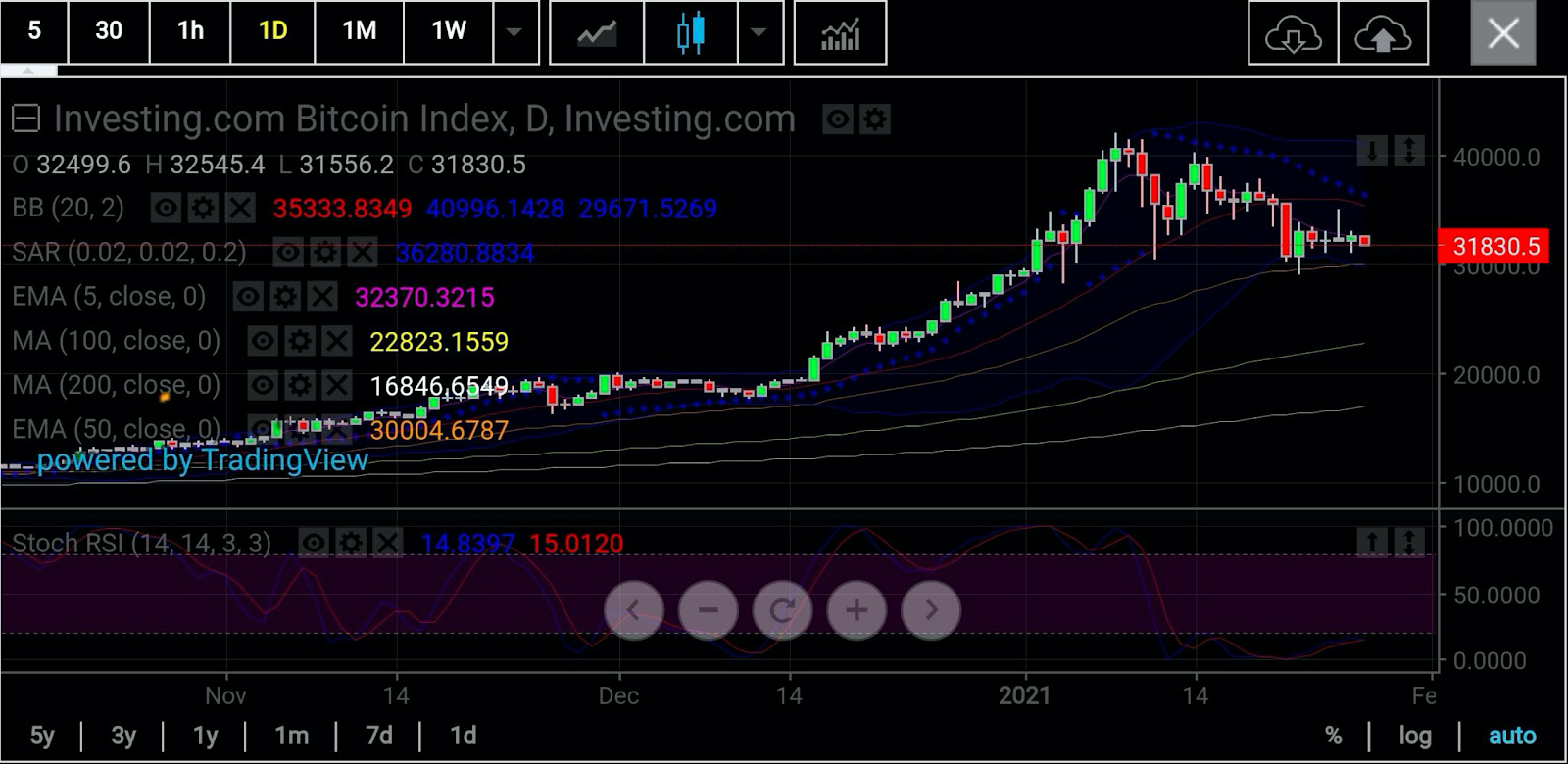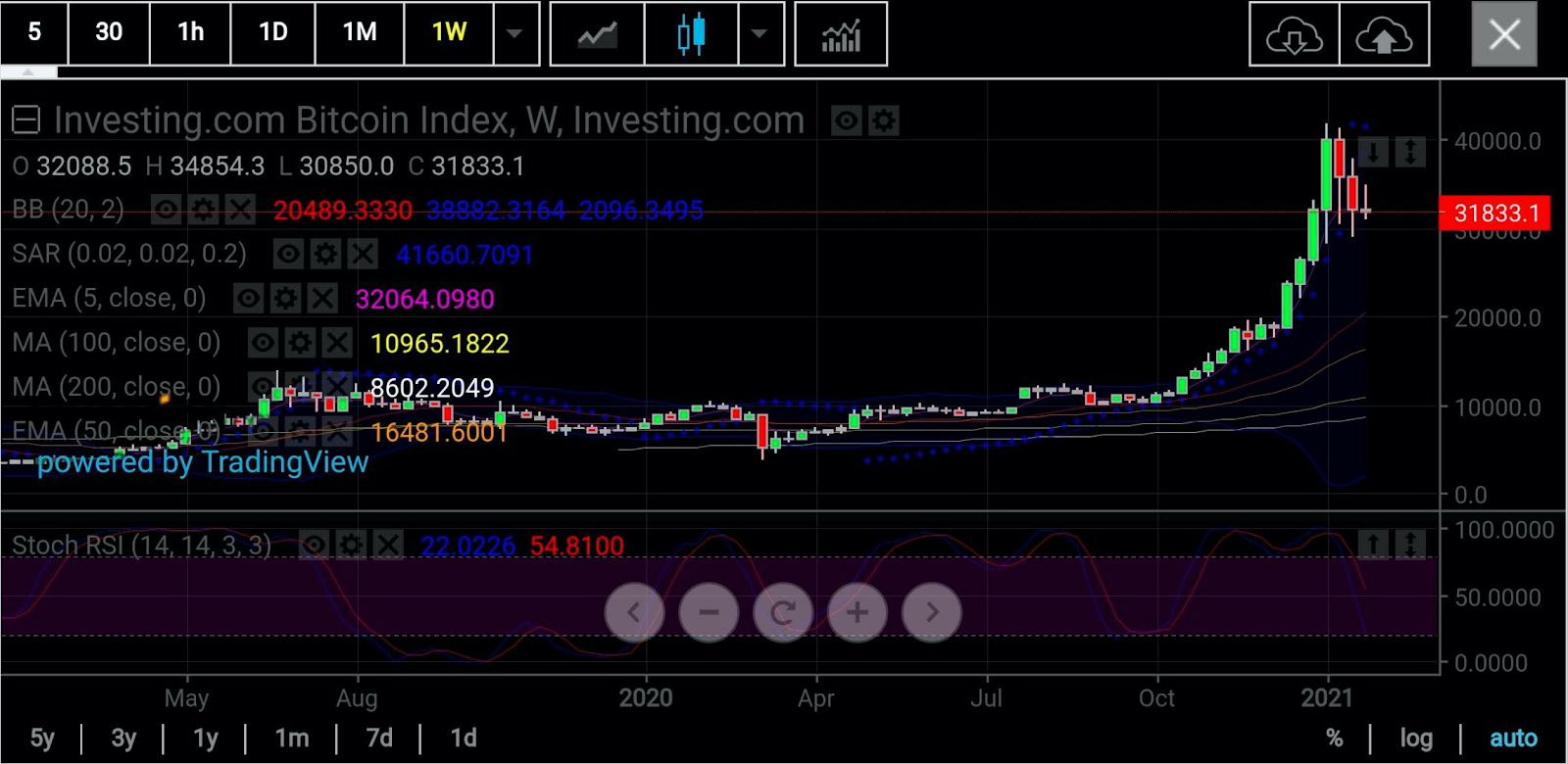Whether it’s the drool-worthy action in GameStop (NYSE:GME) shares or incessant stories of more crypto regulation, the retail mania in Bitcoin seems to have suddenly gone poof.
After Friday’s near $2,200, or 7%, boost that might have enthused at least some into thinking the Big B of the digital coin world was back, activity has slowed again.
At Tuesday’s close, Bitcoin had given back almost $550, or 1.7%, from last week’s close to stand just shy of $32,520. Sure there was Monday’s intraday high of nearly $34,700. But it was hardly the epic stuff of the first ten days of January when it rose 46% to record highs above $41,000. Bitcoin achieved in those ten days what it took the alt-currency whole months in December and November to accomplish. The majority of “alt”, or alternative, coins have also faded from recent all-time highs.
So, what’s happened?
This Rally Needs Fresh Drivers, Really
Well, for one thing, recycled news of ballooning US fiscal deficits, debt and inflationary pressures alone don’t seem enough to drive Bitcoin into a frenzy like they did just weeks ago.
Remember the story that cryptos are safer than safehavens like gold for anyone wishing to hedge against fiat currencies? Well, everyone’s heard that now. And fewer are subscribing to it, after the actions of the past three weeks, or buying Bitcoin on that reason alone.
Regulation, or rather, fear of it, is another thing.
Bitcoin got hit by a wave of bad press at the end of last week when South Africa's Direct Selling Association of South Africa asked the African Union to initiate a continent-wide effort to stamp out Ponzi schemes that could target cryptos.
Bloomberg added on Tuesday that South Africa’s finance-industry regulator wanted to be able to fully prosecute perpetrators of fraud and oversee dealing in cryptocurrencies.
Regulation, And More Regulation
Newly-minted US Treasury Secretary Janet Yellen did not mince her words either, saying that while Bitcoin and other digital currencies provided some benefits, “many are used, at least in a transaction sense, mainly for illicit financing."
She added:
"I think we really need to examine ways in which we can curtail their use and make sure that money laundering doesn't occur through those channels."
And Gary Gensler, President Biden’s pick for the role of Securities Commission Chairman, is expected to have a similar role at SEC as his previous assignment at the Commodity Futures Trading Commission: bringing order to a largely ungoverned ecosystem.
Combined, these were enough to unnerve even the most ardent crypto bulls. Punters want to make fast, not slow, money, and they want to make it safely too. Speculation is that some of the Bitcoin crowd may have migrated to GameStop, as shares of the video game retailer rocketed a lunatic 740% over the past three weeks.
Not all Bitcoin news has been negative either. This week, Coindesk.com, citing sources, reported that Harvard, Yale, and Brown have been buying Bitcoin for at least a year. News that America’s top three Ivy League colleges could trust their endowment money to Bitcoin would have felt like a ray of sunshine piercing across the crypto space amid the dark clouds of regulation gathering over it.
So, what will take it to bring the Bitcoin rally back?
A Real Good Bargain Will Help
Like any market, good positive developments or stories will help Bitcoin crawl out of the hole it’s in. If not, a good bargain will.
Ed Moya, who tracks the crypto space in his daily markets roundup, thinks Bitcoin needs to fall below $30,000. He says the regulatory headaches for Bitcoin aren’t going away, but the price isn’t collapsing either for it to generate a new wave of buying, and that’s a problem.
Federal Reserve Chair Jay Powell, who will hold his monthly news conference at 2:00 PM ET (19:00 GMT) Wednesday, might trigger a bigger sell-off in Bitcoin if he ends up voicing more optimism than expected in the pandemic-hit US economy, said Moya. He adds:
“Bitcoin seems poised to consolidate a little more, but if the Fed is not dovish enough and the dollar rebounds, the $30,000 level could easily break.”
If Not A $30,000 Low, Then A Bottom Of Around $20,000
Greg Michalowski at ForexLive concurs with Moya, saying on Wednesday: “The price needs to crack below Sunday's low and today's low of $30,830.”

Sunil Kumar Dixit of SK Dixit Charting in Kolkata, India, is, meanwhile telling Bitcoin proponents to brace for an even lower bottom—of just above $20,000—if they wish to recapture the mania of November through the first 10 days of January. Adds Dixit:
“Without a crash, the upside for Bitcoin is conditioned by its ability to hold above $32,500-$33,000 for next above $35,500-$38,900. This can accelerate the upside momentum for a big leap toward the $50,000 station.”
“But I’m more of a believer that the path of least resistance for Bitcoin now is lower. If so, we’ll see sellers breaking below the 50-Day Exponential Moving Average, which sits at $30,000. This can strengthen the correctional path to below $27,500, taking it eventually to the 1000-Day Simple Moving Average of $22,800 and the 20-Week SMA of $20,500.”

All charts courtesy of S.K. Dixit Charting
Ambrose O'Callaghan, posting on Motley Fool, said Bitcoin’s daily chart showed a ‘gravestone doji’ forming as early as Monday. Like OANDA’s Moya, he thinks the dollar’s performance will be key to determining Bitcoin’s comeback, especially as President Biden pushes for his $1.9 trillion coronavirus stimulus plan. Adds O'Callaghan:
“North American stocks are still scorching hot, even as the COVID-19 pandemic continues to devastate much of the economy. Investors should closely watch the behaviour of the US dollar, especially as the highly anticipated stimulus package looms large. The market reaction to this package may shape Bitcoin’s trajectory past January.”
Investing.com’s own Daily Technical Outlook for Bitcoin calls for a ”Strong Sell.”
Should the contract extend its bearish trend, a three-tier Fibonacci support is forecast, first at $31,609, then $31,569 and later at $31,504.
However, should the trend in Bitcoin turn positive, then a three-stage Fibonacci resistance will likely form, first at $31,739, then $31,779 and later at $31,844.
In any case, the pivot point between the two is $31,674.
Instead of concluding with my usual counsel that investors temper any chart outlooks with fundamentals and moderation, I will append O'Callaghan’s caution on how Bitcon investors, particularly need to proceed:
“It has been fascinating to watch the bull market for cryptos over the past six months. Still, investors need to be extremely cautious in this environment. Those who want to jump in on the Bitcoin craze should view it as a long-term pledge at this stage. Markets are overheated right now, and Bitcoin has burned newcomers before.”
Disclaimer: Barani Krishnan uses a range of views outside his own to bring diversity to his analysis of any market. He does not own or hold a position in the commodities or securities he writes about.
